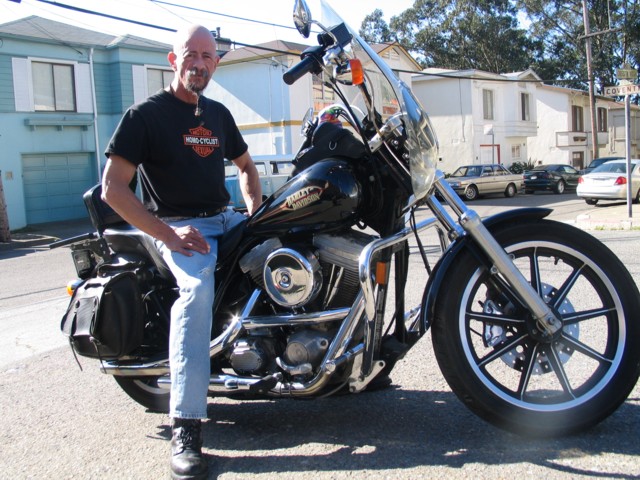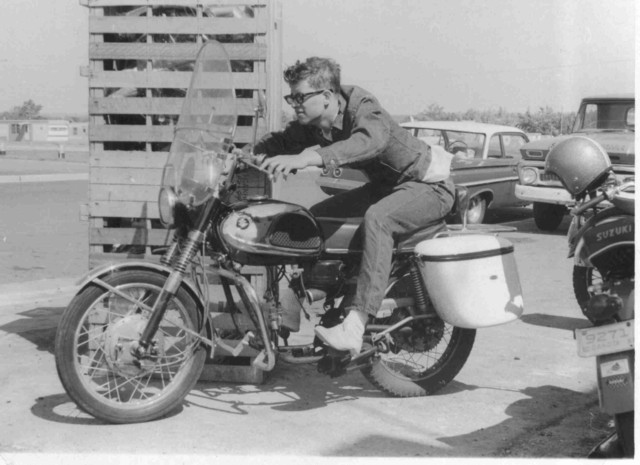Motorcycling
This space is still under construction. It will detail my 40 year interest in riding motorcycles. More pictures and text will be added.

The present - This is my present motorcycle, It is a 1992 Harley Davidson FXR. The model is also known at the Superglide. I have nicknamed the bike "The Roc", after the mythical bird of great size and strength.
I have owned the bike since it was new. I bought it from Dudley Perkins Harley Davidson in San Francisco. It now has about 76,000 miles on it.
In recent years, I have not been riding as much as I had been riding in past years. Most of my riding is now restricted to long road trips. Each year, I ride the bike to Death Valley as part of the Queer Biker Invasion of Death Valley, a ride I happen to (dis)organize. I also try to take another one or two long rides each year. This past summer (2005), I rode again to massive gathering of Harley riders knows as the Sturgis Bike Week in Sturgis, South Dakota. This was the third time I have ridden to Sturgis. The route to Sturgis passes through some of the most beautiful and interesting scenery in North America. Each time I have ridden alone. Each time was trouble free. Each time was a great experience. This last trip totaled 3,022 miles of pure joy.
I like the Harley both for what it can do, and what id can't do. What is can do is get me where I want to go in a style I like. What it cannot do is go faster than about 100 miles per hour. The limitations on speed help me to have a nice, slower, safer ride. This comes out of life experience. I have found in the past that sometimes I have more guts than brains, and that is not good on the motorcycle.
The past - Motorcycles I have owned
About 1965 I became interested in motorcycles. Honda was advertising that "You meet the nicest people on a Honda". I was also going to college where parking was scarce, so I kept seeing the advantages of having a motorcycle. I began to read motorcycle magazines, and on occasion, renting a dirt bike.
I tend to buy new bikes and keep them a long time, putting lots of miles on them. The following is a list of the bikes that I have owned and something about them. As I find old pictures of these bikes, I will scan them and add them to this site.
 1st bike - 1967 Suzuki X6 Hustler - This is the
motorcycle that began it all for me. Before this, it was renting dirt
bikes and reading magazines. I had to wait until I was 21 to be able to
buy my first bike. In those years, a person did not reach the age of
majority until he or she was 21, and that meant that I could not sign a contract
to buy a motorcycle without my parent's signature. They were clear with me
that they did not approve of my riding a motorcycle, fearing I would get hurt in
an accident. They tried to bribe me out of buying this bike by offering to
give me the down payment on a Dodge Dart convertible (a really neat car in those
days), but I was adamant about wanting to own a motorcycle. I paid about
$700 for the bike.
1st bike - 1967 Suzuki X6 Hustler - This is the
motorcycle that began it all for me. Before this, it was renting dirt
bikes and reading magazines. I had to wait until I was 21 to be able to
buy my first bike. In those years, a person did not reach the age of
majority until he or she was 21, and that meant that I could not sign a contract
to buy a motorcycle without my parent's signature. They were clear with me
that they did not approve of my riding a motorcycle, fearing I would get hurt in
an accident. They tried to bribe me out of buying this bike by offering to
give me the down payment on a Dodge Dart convertible (a really neat car in those
days), but I was adamant about wanting to own a motorcycle. I paid about
$700 for the bike.
I chose the Suzuki 6 Hustler for a number of reasons. At 298 lbs, 247 cc, 30 horsepower and a six speed transmission, the bike was FAST! The acceleration was fantastic compared to other bikes and virtually all cars. And, because it was under 300 lbs, I got an break on insurance. In those days, the insurance companies had a dividing line between bikes over and under 300 pounds with the heavier bikes being considerably more expensive to insure.
I rode it like hell, dropped it a couple of times. In 1968, I took it on a cross country bike trip. That was huge mistake. Another example of my having more guts than brains. The bike broke down repeatedly. When I finally got back to New York, I sold the bike and bought a 1969 Kawasaki W2-SS.
2nd bike - 1969 Kawasaki W2-SS - This is a bike not many people remember but it was an incredible bike. It was modern Japanese copy of a early 1950's pre unit construction 650cc BSA; it had a separate engine and transmission. It had a high reving short stroke engine. And perhaps more importantly, it had a modern Japanese electrical system. In those days, the British bikes had electrical systems made by Lucas, also known as the Prince of Darkness. The joke going around in those days went like this, "Why do the British like warm beer?". Answer - "Because Lucas also makes refrigerators". This was the last bike I owned that only had a kick starter. The price of the bike new in 1969 was $1,000.
I did a lot of fast riding on this bike. Early one Sunday morning, some friends and I were riding on the New York State Thruway. There was a sign which said "Albany, 90 miles". 57 minutes later we were in Albany. The bike had a four gallon gas tank, large for those days. Gas was about 30 cents a gallon and I could fill up the tank for about a buck. (Now I have managed to do things on a bike I have never been able to do before, like get $10 worth of gas into the tank of my Harley). I have many pleasant memories of this bike.
3rd bike - 1975 Honda CB360 - In February, 1976 I moved to California on an airplane. I only took those things that I could take with me on the plane (I had ten large boxes of stuff; it was only $5 extra for each box). But no motorcycle. So in May, 1976, after securing a job, I bought a 1975 Honda CB360 motorcycle. The price was $700.
There had been a recession in Japan in 1975 and they had overproduced motorcycles and in 1976 still had a lot of unsold bikes from the previous year. The CB360 was a marvelous piece of engineering. In 1977, I rode it two up to and from San Franciso to Seattle and back, and did not feel it was underpowered.
I appears I was not the only one who liked this bike. In 1978 it was stolen.
4th bike - 1978 Honda CB750K - This was an absolutely incredible piece of machinery, costing about $1,700. Honda had introduced the 750 in 1969 and from the beginning, it changed the course of motorcycle history. It was the first of what became knows as the UJM (universal Japanese machine). There were so many copies of this design by other makers that it seemed like every bike from Japan was a four cylinder, overhead cam bike.
By the time I bought the bike in 1978, the Honda engineers had 9 years to work out all the minor flaws in the bike. It was smooth, powerful, reliable, nimble and enjoyable in every way. I rode it lovingly for years.
5th bike - 1982 Honda 750 Sabre - This is the only bike I ever bought used, buying it at several years of age with 21,000 miles on the odometer for about $800. (From about the mid 1980's onward, there has been a large number of Japanese motorcycles available used for what I consider very little money compared to the value of these machines.) I only had it for a few years, and enjoyed the ride. It was red, fast, but in a lot of ways, just didn't seem right for me. After I dropped it at a wet, greasy stop sign, I decided to sell it. It's spell had been broken.
6th bike - 1992 Harley Davidson FXR Superglide - After years of thinking about it, I realized I had the financial resources to buy a big Harley. I chose the FXR Superglide. While the mechanics of the motorcycle were identical to that of every other Harley, it was less expensive because it had less chrome and do dads. It has been my steed since.
I bought the Harley for a number of reasons. First and foremost, I thought it was a sexy bike that just seemed to fit me. I am also a practical person and realized that it would probably hold it's resale value better than any other bike. Today, I can get at least 75% of the cost of the bike back if I sold it. True, I have put many accessories on the bike, and today's dollars are not worth as much, but 14 years and 76,000 miles and I can still get 75% of the original cost back. Amazing.
There were several other practical reasons for getting this bike. It is a slow bike, and that means I can't get into as much trouble. It is also a bike that, regardless of how long I live, there are likely to be numerous companies making various spare parts for this bike. It will always be able to be maintained. The Harley Davidson Motor Company has a program where for about $2,000 they will completely rebuild the bike's engine. Add the cost of removal and reinstallation, and that is a bargain. One can't do that with virtually any other make of motorcycle. They get to a certain age or condition and it is best to scrap it and start over. Harley's go on forever.
The future of my motorcycling
Where might all this go from here? I don't know. I've looked longingly on motorcycles with electronic cruise control. I envision myself getting on the open highway, putting it on cruise control at a relative slow speed (like whatever the posted speed limit is), and just cruising down the highway. I also like the idea of antilock brakes. So, when Harley offers a Dyna model with electronic cruise control and ABS, I'll but a new bike. Until then I'll keep riding what I have.
Last updated December 9, 2005
Home Background Tattoo Project Queer Biker Invasion of Death Valley e mail